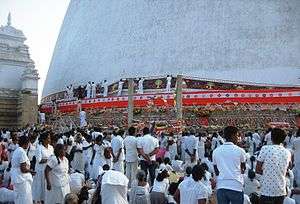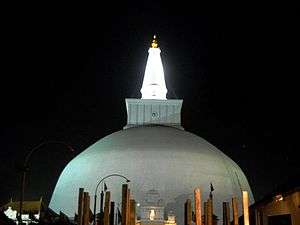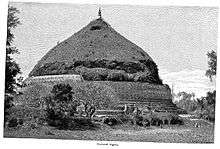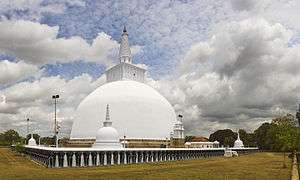Ruwanwelisaya
| Ruwanweli Maha Seya රුවන්වැලිසෑය | |
|---|---|
|
The Ruwanwelisaya Stupa | |
 Location in Sri Lanka | |
| Basic information | |
| Geographic coordinates | 8°21′0″N 80°23′47″E / 8.35000°N 80.39639°ECoordinates: 8°21′0″N 80°23′47″E / 8.35000°N 80.39639°E |
| Affiliation | Theravada Buddhism |
| Country | Sri Lanka |
| Architectural description | |
| Founder | King Dutugamunu |
| Completed | circa 140 BC |

The Ruwanwelisaya is a stupa in Sri Lanka, considered a marvel for its architectural qualities and sacred to many Buddhists all over the world.[1] It was built by King Dutugemunu c. 140 B.C., who became lord of all Sri Lanka after a war in which the Chola King Elara, was defeated. It is also known as Mahathupa, Swarnamali Chaitya, Suvarnamali Mahaceti (in Pali) and Rathnamali Dagaba.
This is one of the Solosmasthana (the 16 places of veneration) and the Atamasthana (the 8 places of veneration in the ancient sacred city of Anuradhapura). The stupa is one of the world's tallest monuments, standing at 103 m (338 ft) and with a circumference of 290 m (951 ft).[2] The Kaunghmudaw Pagoda in Sagaing, Myanmar is modeled after this stupa.[3]
The stupa was an ancient ruin in the 19th century. After fundraising efforts by Sinhalese bhikkhu, the stupa was renovated in the early 20th century.[4] The Ruwanveli Seya Restoration Society was founded in 1902 and the final crowning of the stupa took place on 17 June 1940.[4]
The largest Stupa after Ruwanwelisaya was build in was the Kotmale Mahaweli Maha Seya. This stupa took 33 years and 3 months to complete.
Construction of the Great Stupa
Materials used
The ancient texts recount the following:[5]
- From the bank of the river Gambhīra, situated a yojana (a distance measure) to the north of Anuradhapura bricks were acquired;
- From the village Avuruvini, situated three yojanas to the north-east, nuggets of gold were acquired;
- From the village Tambapittha, situated seven yojanas to the east, copper were acquired;
- From the village Samanveve, situated four yojanas to the south-east, gems were acquired;
- From the rock-cave Ridi, situated eight yojanas to the south, silver were acquired;
- From the small town Uruvel, situated five yojanas to the west, pearls and corals to the size of myrobalan (nelli) fruits were acquired;
- From the village Pelavapi, situated seven yojanas to the north-east, four large gems were acquired.
The full moon day
King Dutugemunu began the work of building the stupa during Vesak, on the full-moon day of the month of Vesakha (April–May), under the constellation of Visakha. In Buddhism this is considered a sacred full-moon day on which numerous events occurred, such as:[5]
- The definite declaration by Dīpankara Buddha to the ascetic Sumedha Bodhisatta Gotama in a past life) that he will become a Buddha;
- The birth of Bodhisatta Gotama from Tusita heaven in the human world;
- The Enlightenment of Prince Siddhartha
- His arrival in the city of Kapilavatthu;
- His performance of the Twin Miracle;
- His arrival in Sri Lanka three times;
- His passing into Parinibbāna;
- The disembarkation of Prince Vijaya (Singha) in Sri Lanka
- The coronation of the great king Devanampiya Tissa
Foundation
On such a full-moon day King Dutugemunu had the inscribed stone pillar that was erected by King Devanampiya Tissa, removed;
- had the site leveled;
- had it dug to a depth of seven cubits;
- had round stones spread there by warriors;
- and had the stones broken with hammers;
- then he had them stamped down by elephants;
- fine clay was brought from the Himalayas by Arahant novices, spread over the layer of stones;
- had bricks laid over the fine clay, rough plaster over the bricks, quartz over the rough plaster, a network of iron over the quartz, fragrant clay over the network of iron, white stones over the fragrant clay, rock-crystal over the white stones, and slabs of stones over the rock-crystal.
- Then he had mercury, resin of the wood-apple, and fine clay mixed together; had these spread over the slabs of stones; and had bronze sheets eight inches thick laid over these.
- He had arsenic and sesame oil mixed together; had these spread over the bronze sheets; and had silver sheets four inches thick laid over these.
When the king had thus built and completed the foundation of the Great Stupa, he arranged that the foundation stone should be laid on the full-moon day of the month of Āâsàëha (June–July).
He then had Anuradhapura decorated like a divine city along with the terrace of the Great Stupa. Ninety-six koñis of Arahants were present On the full-moon day of the month of Āsāëha, under the constellation of Uttarā-sāëha, he laid the foundation-stone of the Great Stūpa and determined: 'Should the work I carry for this Stupa be completed safely, may then the Venerable Arahants Buddharakkhita, Dhammarakkhita, Saïgharakkhita and Ānanda arrive and stand at the four quarters of the Great Stupa's terrace.'
This happened as he determined. The Arahant Indagutta arranged that it should thus happen. In addition, the Venerable Arahants, Siddhattha, Maïgala, Paduma, Sivalī, Candagutta, Indagutta, Suriyagutta, Cittasena, Jayasena, and Acala looking eastwards arrived and stood in front of the pitcher placed at the gate of this festive occasion. Supatiñhita, the son of Nandisena and Sumana devi, and the minister appointed for the festive ceremonies, walked around the relic-chamber and went and brought a staff made of silver for measuring the circular boundary of the Stupa. When Arahant Siddhattha saw the minister walking thus around the relic-chamber and measuring too large dimensions, he ordered him to measure moderate ones. On hearing the name of Arahant Siddhattha, the names of the eleven other Arahants, and the name of the minister and his parents, king Dutugemunu felt particularly glad, thinking: 'The work on the Stūpa will certainly be successful.'
He then had eight large water pots of gold and eight of silver placed in the midst of the Great Stupa, and had a hundred and eight vases placed around the large water pots. He had, likewise, eight bricks of gold placed in eight corners and a hundred and eight bricks of silver around each of the bricks of gold.
The Stupa is blessed

Arahant Cittasena placed a lump of fragrant resin in the east side upon the boundary line drawn around the Great Stūpa. Arahant Jayasena sprinkled scented water over it, and when, under the constellation of Uttarāsāëha, Supatiññhita, the minister for the festive ceremonies, placed bricks of gold together with lavish offerings over the scented water.
It is said that: the earth, all of two hundred seventy thousand yojanas, roared and quaked at that time.
He had through his sons, similarly, placed bricks of gold in the other seven sides of the Great Stupa. Afterwards, king Dutugemunu and the people there honoured with gifts the Arahants who were seated at the four quarters, and took themselves seats to hear a Dhamma talk delivered that day by the great Arahant Piyadassī.
Having heard it, forty thousand people became Arahants, forty thousand were established in the fruit of stream-entry (sotāpatti-phala), a thousand became once-returners (sakadāgamis), and a thousand became non-returners (anāgamis). Eighteen thousand monks and fourteen thousand nuns became Arahants.
Buddha's Relic

After The Buddha's Parinibbāna, His relics were enshrined and worshipped in stupas by Princes of eight countries two quarts in each country. The two quarts of relics that were enshrined in the village Rāmagāma were, according to The Buddha's determination, destined to be enshrined in the Great Stūpa Ruvanveli.King Dutugemunu who, on the full-moon day of the month of Āsāëha (June–July), under the constellation of Uttarāsāëha, would officiate in the ceremony for the enshrining of the relics in the Great Stūpa, worshipped the Sangha (Order of monks) on the day before the full-moon day, reminded them that tomorrow is the appointed day for the enshrining of the relics and requested them to give him the relics. The Saïgha ordered then the novice Arahant Soõuttara, who was gifted with the six supernormal faculties, to bring the relics, which Arahant Soõuttara manages to bring and offer to the Sangha.
Then king Dutugemunu received from the Sangha the Buddha's relics upon his head in a casket and departed from the golden pavilion in the midst of manifold offerings and honours made by gods and Brahmas. He circumambulated the relic-chamber three times, entered to it from the east, and when laid the relic-casket on a silver couch one koñi worth, that was arranged in the north side. An image of the Buddha was then, according to the Buddha's determination, created in the lion's reclining posture (sīhaseyya), and all the relics were enshrined within that image. When the enshrining of the relics in the Great Stūpa Ruvanveli was completed, the two novices Uttara and Sumana closed the relic-chamber with the stone-blocks that were previously hidden to be used as a lid.
In the Thupavamsa numerous types of beings attended the enshrinement of the relics into the Mahathupa; including the Naga king Mahakala who until recently guarded them. The relics were to be placed atop a golden throne crafted by Visvakarman the divine artificer; the throne brought by Indra. Brahma offers his invisible umbrella of sovereignty, with the king Dutthagamani offering his own. The arhat Indagutta creates a metal canopy over the universe, so that Mara will not interfere, as monks chanted the sutra pitaka. Dutthagamani ceremoniously enters with the urn atop his head; but as he is about to place the urn on the golden throne, the relics rise into the air and form Buddha, with each of the 32 major signs and 80 lesser signs of a great man. In this form he performs the twin miracle of fire and water, fulfilling the fifth of his death bed resolutions. One hundred and twenty million gods and humans gain arhatship from this experience. The relics return to the urn and they are laid to rest and the chamber sealed with forty meter stone slabs.[6]
"The relic-chamber shall not shake even by an earthquake; flowers such as jasmine that were offered on that day shall not wither till the end of Buddha Gotama's Dispensation; the lamps that were kindled with ghee-oil shall not be extinguished; the clay that was mixed with perfume and sandalwood shall not dry; even a single scratch shall not appear within the relic-chamber; stains shall not appear in any of the golden goods that were offered.' All this occurred by the determination-power of all Arahants present. They determined also that inimical persons should not be able to even see the relic-chamber. Furthermore, by order of king Dutugemunu, the people of Srī Lanka enshrined, along with many other objects such as golden and silver caskets, thousand more of the Buddha's relics over the relic-chamber."
The Great Stupa is constructed
When the unique Great Stūpa Ruvanveli was completed as far as the square turret 10, and while ninety-six koñis of Arahants were chanting protective suttas, the great king Dutugemunu who reigned in Srī Lanka for twenty-four years, had his record of meritorious deeds read and, while looking at the Great Stūpa, he died and was born as a divine king in the Tusita-heaven. His brother, the king Saddhatissa, completed the remaining work at the Great Stūpa and later was also born in the Tusita-heaven.
The Great King
During the Dispensation of the future Buddha Metteyya, king Dutugemunu will become the Buddha's chief disciple on His right side. King Saddhātissa will become the chief disciple on His left side. Kāvantissa and Vihāra Mahā- Devī will become the parents of the future Buddha Metteyya. Princess Anulā, the younger sister of king Kāvantissa, will become the chief Queen of the Bodhisatta Metteyya. Prince Saliya will become the son of the Bodhisatta Metteyya. Saõgha, king Dutugemu's Chancellor of the Exchequer, will become the chief attendant of the Buddha Metteyya. The Chancellor's daughter will become the chief she-attendant.
See also
- Ancient stupas of Sri Lanka
- List of tallest structures built before the 20th century
- Ancient Constructions of Sri Lanka
- Architecture of ancient Sri Lanka
- Architecture of Sri Lanka
- Jetavanaramaya
- Atamasthana
- Mahawansa
References
- ↑ "Ruwanweliseya". Sri Lanka Heritages. com. Retrieved 25 September 2015.
- ↑ "Ruwanweliseya Stupa (144 BC), Anuradhapura". Riolta Sri Lankan Holidays. Retrieved 24 February 2013.
- ↑ Myo Aung and H. Kraft`. Upper Myanmar Mandalay Pyin Oo Lwin Sagaing Monywa Mingun Mogok Shwebo. Books on Asia.
- 1 2 Swarnamali Maha Seya and the forgotten monk, July 13, 2012
- 1 2 Nauyane Ariyadhamma Maha Thera. "Ruvanveli Seya - The Wonderous Stupa Built by Gods and Men" (PDF). http://www.beyondthenet.net/. Retrieved 25 September 2015. External link in
|publisher=(help) - ↑ John S. Strong (2007). Relics of the Buddha. pp. 160–171.
- This page incorporates content from Dr. Rohan Hettiarachchi's used with permission of website owner.
http://www.srilanka.travel/star-tracing-stupas-of-sri-lanka
Bibliography
- Shereen Amendra, "Beyond the Seeing Eye: The Mahathupa of Lanka: An Insight", Shereen Amendra, 2006, ISBN 9555009805
- Ulrich von Schroeder, "Buddhist Sculptures of Sri Lanka", Visual Dharma Publications, 1990, ISBN 962-7049-05-0
External links
| Wikimedia Commons has media related to Ruwanwelisaya. |
- Mini Stupa
- photos of Ruwanwelisaya
- Swarnamali goddess (ස්වර්ණමාලී දෙව්දුව)
